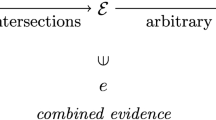Abstract
Reliabilism about epistemic justification – thethesis that what makes a belief epistemicallyjustified is that it was produced by a reliableprocess of belief-formation – must face twoproblems. First, what has been called ``the newevil demon problem'', which arises from the ideathat the beliefs of victims of an evil demonare as justified as our own beliefs, althoughthey are not – the objector claims – reliablyproduced. And second, the problem of diagnosingwhy skepticism is so appealing despite beingfalse. I present a special version ofreliabilism, ``indexical reliabilism'', based ontwo-dimensional semantics, and show how it cansolve both problems.
Similar content being viewed by others
REFERENCES
Chalmers, D. (1996): The Conscious Mind, Oxford: Oxford University Press.
Cohen, S. (1984): 'Justification and Truth', Philosophical Studies 46, 279-295.
Conee, E. and Feldman, R. (1998): 'The Generality Problem for Reliabilism', Philosophical Studies 89(1), 1-29.
Elga, A. (MS): 'Defeating Dr. Evil with Self-Locating Belief', unpublished.
Evans, G. (1979): 'Reference and Contingency', The Monist 62(2). Reprinted in Evans (1985), 178-213.
Evans, G. (1985): Collected Papers, New York: Oxford University Press.
Foley, R. (1993): Working Without a Net, New York: Oxford University Press.
Goldman, A. (1991): 'Epistemic Folkways and Scientific Epistemology', in his Liaisons: Philosophy Meets the Cognitive and Social Sciences, Cambridge, MA: MIT/Bradford.
Goldman, A. (1999): 'A priori warrant and naturalistic epistemology', Philosophical Perspectives, vol. 13: Epistemology, pp. 1-28.
Kaplan, D. (1989): 'Demonstratives', in J. Almog, J. Perry and H. Wettstein (eds.), Themes from Kaplan, New York: Oxford University Press, pp. 481-563.
Lewis, D. (1970): 'Anselm and Actuality', Nous 4. Reprinted with Postscripts in Lewis (1983), 10-20.
Lewis, D. (1973): Counterfactuals, Cambridge, MA: Harvard University Press.
Lewis, D. (1983): Philosophical Papers Volume I, New York: Oxford University Press.
Sosa, E. (1991): Knowledge in Perspective, New York: Cambridge University Press.
Sosa, E. (1993): 'Proper Functionalism and Virtue Epistemology', Nous 27(1), 51-65.
Sosa, E. (forthcoming): 'Goldman's Reliabilism and Virtue Epistemology', Philosophical Topics.
Stalnaker, R. (1978): 'Assertion', in P. Cole (ed.), Syntax and Semantics, vol. 9: Pragmatics, New York: Academic Press. Reprinted in Stalnaker (1999), pp. 78-95.
Stalnaker, R. (1999): Context and Content, New York: Oxford University Press.
Author information
Authors and Affiliations
Rights and permissions
About this article
Cite this article
Comesaña, J. The Diagonal and the Demon. Philosophical Studies 110, 249–266 (2002). https://doi.org/10.1023/A:1020656411534
Issue Date:
DOI: https://doi.org/10.1023/A:1020656411534




